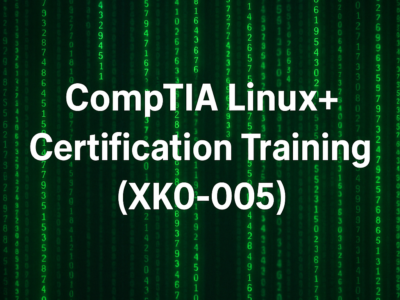CompTIA Linux+ Certification Training (XK0-005)

Master the Command Line. Power the Open Source World.
🕒 Duration: 120 Hours | 💻 Format: Live Virtual or In-Person | 📅 Schedule: 6 Weeks (5 Days/Week, 4 Hours/Day)
Why Take This Course?
Linux powers the backbone of modern infrastructure — from servers to cloud environments, containers to security tools. If you want to break into IT or advance into system administration, CompTIA Linux+ is your gateway.
This 120-hour instructor-led course teaches you how to confidently operate and administer Linux systems using hands-on, real-world examples — preparing you for the XK0-005 certification exam and real enterprise environments.
What You’ll Learn
✅ Master the Linux command line (Bash)
✅ Manage users, groups, permissions, and services
✅ Troubleshoot hardware, boot processes, and network issues
✅ Work with software packages and storage systems
✅ Build secure, automated, and efficient Linux environments
✅ Prepare for the CompTIA Linux+ XK0-005 certification exam
Course Includes
- Real-World Labs with TestOut Linux Pro or instructor-built Linux VMs
- Quizzes, challenges & certification exam prep
- Certificate of Completion from LTP Technologies
- PDF handouts, Linux command cheat sheets, and diagrams
- 1-on-1 instructor support + recorded sessions
| Module | Lesson | # |
| Module 1: Linux Foundations & Command Line Mastery | Intro to Linux, Distros, Kernel, Open Source Principles | 1 |
| Shell Access, Navigating File System, Basic Commands | 2 | |
| Managing Files & Directories, Wildcards, Redirection, Pipes | 3 | |
| Users, Groups, Permissions (chmod, chown, umask) | 4 | |
| Practice Lab: File System Navigation & Permissions | 5 | |
| Module 2: User Management, Storage, & Boot Process | Advanced User/Group Management, sudo, passwd policies | 6 |
| Disk Partitioning (fdisk, gdisk), LVM Basics | 7 | |
| File Systems (ext4, xfs), Mounting, fstab | 8 | |
| Boot Process, GRUB, runlevels/systemd targets | 9 | |
| Practice Lab: Users, Disks, & Boot Troubleshooting | 10 | |
| Module 3: Software, Processes & Package Management | Process Management (ps, top, jobs, kill), Scheduling (cron) | 11 |
| Package Managers: apt, yum/dnf, rpm, Snap & Flatpak | 12 | |
| System Services: systemd, journald, enabling/disabling units | 13 | |
| Logs & Monitoring (journalctl, logrotate, top, uptime) | 14 | |
| Practice Lab: Packages, Services & System Logs | 15 | |
| Module 4: Networking & Troubleshooting | Network Configuration (ip, nmcli, ifconfig, netplan) | 16 |
| DNS, DHCP, Hosts File, Network Troubleshooting Tools | 17 | |
| Firewalls: UFW, firewalld, iptables | 18 | |
| SSH, Remote Access, File Transfer (scp, rsync) | 19 | |
| Practice Lab: Network & Firewall Troubleshooting | 20 | |
| Module 5: Security, Bash Scripting & Automation | File Permissions Deep Dive, Sticky Bits, ACLs | 21 |
| User & System Security Best Practices | 22 | |
| Intro to Bash Scripting: variables, conditionals, loops | 23 | |
| Script Debugging, Scheduling with cron/anacron | 24 | |
| Practice Lab: Secure Linux Automation | 24 | |
| Module 6: Final Project, Mock Exam & Prep | Comprehensive Review: Commands, Services, Troubleshooting | 26 |
| Lab Simulation: Real-World Troubleshooting Scenarios | 27 | |
| Practice Test 1 + Review | 28 | |
| Practice Test 2 + Final Lab Challenge | 29 | |
| Final Project Submission & Instructor Feedback | 30 |
Outcome
By the end of this course, you’ll be able to confidently manage Linux systems in enterprise settings and pass the CompTIA Linux+ certification exam — setting yourself apart in the world of open-source IT.
At LTP Technologies, Linux isn’t just a topic — it’s our foundation. Join us and gain real-world skills that make you job-ready in just 6 weeks.
Target audiences
- Aspiring Linux System Administrators
- IT Support Technicians looking to level up
- Network+ or A+ certified professionals expanding into Linux
- Career changers entering open-source infrastructure roles
- Security, DevOps, and Cloud hopefuls who need Linux fluency
Requirements
- Basic understanding of computer systems and operating concepts
- CompTIA A+ or Network+ (Optional, but recommended)
- No prior Linux experience is required, but students should be comfortable learning in a command-line environment.
